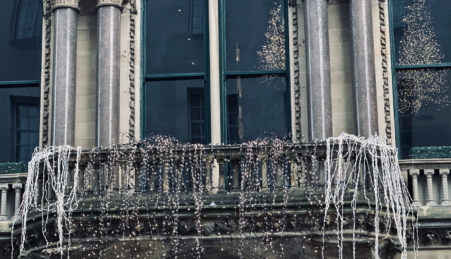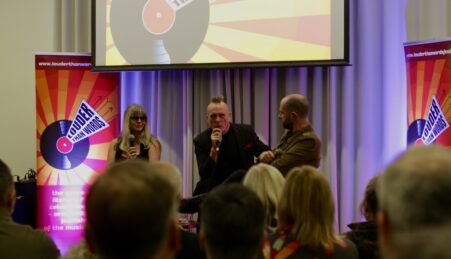
Humanity Hallows Issue 6 Out Now
Pick up your copy on campus or read online
By Emily Oldfield
This weekend saw the second installment of ‘The Modernist Society and Manchester Metropolitan University present GM10’: a coach tour of modernist buildings in Greater Manchester boroughs. The first event in this series was held in May and consisted of the first five boroughs, whilst the most recent event focused on those remaining: Rochdale, Tameside, Stockport, Trafford and Manchester.
Guests taking part in the tour met outside The Manchester School of Art at 10am for a prompt departure. The guides were from the Manchester Modernist Society itself, a group founded in 2009 by Jack Hale, Eddy Rhead and Maureen Ward, dedicated to engagement with and publicity of modernist architecture.
“We like ugly buildings, concrete,” Eddy admitted from the front of the coach as it headed towards Rochdale, the first destination being the chapel of Hopwood Hall.
Shortly after 10.30 am, the coach arrived at Hopwood Hall, currently a Further Education College on the edge of Rochdale. The specific location of interest was the chapel, dating from around 1965 and located on a small mound towards the back of the campus.

It was explained that the chapel was designed by Frederick Gibberd, the architect responsible for Liverpool’s Catholic Cathedral – and some of the background was also detailed. For example, visitors learned that the building was inspired by a certain brother Augustine, who had admired a small round chapel beside Magdalene College in Cambridge and who wanted a similar chapel for Hopwood Hall.
“This was a design all about the experience,” Rhead elaborated. “This could be considered a ‘dry run’ from the designer behind Liverpool Cathedral. It is potentially inspired by The New Vatican, a modernisation programme undertaken by the Catholic church in the 20th century to turn the church around. It gave architects a new language – quite austere.”
Areas of interest on the building included the tower feature, stained glass and also the story that the building itself had often been unoccupied and became decommissioned, even used as a boxing ring in former times.
After photographs, the coach party then proceeded to St. Raphael’s church in Tameside, located in the Millbrook parish, formed in 1958 from the neighbouring parish of Stalybridge. Architect Edward J Massey was responsible for the design of St. Raphael’s and had been commissioned by the Bishop of Shrewsbury at the time, the Right Reverend John Murphy. The foundation stone was laid in 1961 and celebrated a new style of church in which the mass could be said from both sides of the altar. Notably, it featured an external dome in appearance, and a screen of Dalle De Verre glass within.
The coach then proceeded to Stopford House in Stockport, a civic building which the tour cited as an example of brutalism, along with the comment – “There actually aren’t that many genuinely brutalist buildings in Manchester” – hence the focus on Stockport.
Arrival at approximately 12.30pm was followed by a tour of the piazza, observation of exposed aggregate precast panels and ribbed walls, followed by a walk along the modern thoroughfare of Merseyway into the town centre. Buildings of note included a clock tower, an Alan Boyson concrete car park and coloured murals on the side of a former BHS building, with the tour detailing public efforts to get these features listed.
Following a lunch break, the party met outside the Plaza Cinema, with mention of its impressive art-deco inspired interior, before proceeding to the next destination.
Longford Cinema very close to Streford Metrolink station was the location of the next stop of the tour; the investment of 1930s Manchester businessmen Jackson and Newport and designed by architect Henry Elder. The building itself could be considered an example of art-deco inspired by the concept of ‘sex and money’ equating to cinema, as it is designed in the shape of a cash register flanked by two phallic symbols. The tour explained that, in its time, the cinema was seen as highly modern, featuring sound-proofing and under-seat heating. It was also the first in Britain to be illuminated by neon tube lighting. Interestingly, Hale also remarked that the building had inspired a scene in the Manchester-based film 24 Hour Party People and was one of the guide’s favourite modernist buildings in the whole of Greater Manchester.

The final stop of the tour was the Church of St Nicholas in Gorton, designed by Nugent Cachemaille-Day and featuring a distinct Lady Chapel and brightly coloured ceiling, complete with a significant internal space. This stop on the tour was accompanied by a speech from Priest Rachel Mann, who explained more of the history of the church, before guests proceeded to explore for themselves.
The GM10 project is the result of an online call-out for public contributions of favourite modernist buildings in Greater Manchester’s boroughs – with the two coach journeys consisting of the chosen top ten over two journeys. For more information, visit the GM10 website.









Leave a reply